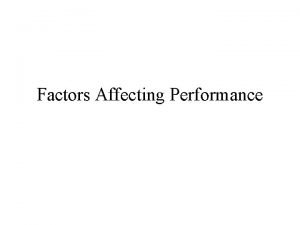Psychological Factors Affecting Performance Personality theories Personality as












- Slides: 12

Psychological Factors Affecting Performance Personality theories

• • Personality as a layered structure Narrow band approach Eysenck’s Type Theory Personality by continuums Trait theories Interactionist approach Summary

Theory 1 – Hollander (1971) ‘Personality as a Layered Structure’ • • Inner psychological core – (not affected by the environment). Fairly permanent qualities, e. g. basic beliefs and values reside here (controlling or dictating behaviour – trait approach) Way we typically or usually respond to certain situations Role-related behaviours – Typical response may be affected by circumstances. Behaviour will be completely different at different times and in different situations and may well be quite unlike our psychological core (interactionist approach) Social environment – Affects our role-related behaviours

‘Narrow Band approach’ Personality TYPE A Impatient Intolerance High levels of stress TYPE B Relaxed Tolerant approach Lower personal stress

• • • ‘Eysenck’s Type Theory’ Stable (reliable and predictable) Extroversion (likes social affiliation) Introversion (avoids social contact) Neurotic (extreme emotions and unreliable) “People don’t have one type of personality or another, they lie on a scale of traits” This research led to the construction of the EPQ and EPI (Eysenck’s Personality Inventory)

• Eysenck regarded personality as largely resulting from inherited (innate) tendencies. • He measured these inherited characteristics through a Personality Inventory (EPI, 1964), and personality questionnaire (1975) • He used factor analysis to identify general trends. • Therefore identifying 2 major personality dimensions on a continuum • Extroversion – Introversion • Stable - Neurotic

Personality continuums • (Extroversion – Introversion). This dimension linked to a person’s Reticular Activating System (RAS). Related to how social or unsocial a person appeared to be. • (Stable – Neurotic). This linked to a person’s autonomic nervous system. Referred to the levels of nervousness and anxiety that a person was susceptible to.

• It was claimed that extroverts were more likely to take part in sport and be more successful, that they prefer team games and that: • Extroverts cope better in competitive and highly charged, stressful situations • Extroverts cope better in the presence of distracting stimuli (e. g. audience, noise) • Extroverts can cope with pain more easily then introverts

Cattell’s theory (1965) • Adopted a trait approach but argued you needed more than 2 dimensions to create a full picture of a person’s personality. • Cattell’s 16 point personality questionnaire would identify certain common traits (possessed by all), and unique traits (possessed by some). • Therefore personality was more dynamic and could fluctuate according to the situation and the environment.

Evaluation of ‘trait theories’ • Did not recognise the specific effects of different environmental situations • Traits are seen as poor predictors of behaviour. Although people have certain core tendencies, or are disposed to act in certain ways, these behaviours are not general but specific to certain situations • Therefore interactionist approaches would be more efficient in predicting behaviour

Interactionist approach • B=f(PE) • B=Behaviour • F=Function • P=Personality Trait • E=Environment

Summary • Hollander (1971) believes personality is subject to both trait and interactionist approaches. • The narrow band approach believes there are only 2 categories of personality • Eysenck’s type theory - “People don’t have one type of personality or another, they lie on a scale of traits” • Cattell’s 16 point personality questionnaire would identify certain common traits (possessed by all), and unique traits (possessed by some).
 Psychological factors affecting sports performance
Psychological factors affecting sports performance Psychological factors affecting sports performance
Psychological factors affecting sports performance Psychological factors affecting sports performance
Psychological factors affecting sports performance Factors affecting entrepreneurship development
Factors affecting entrepreneurship development Psychological factors affecting medical condition
Psychological factors affecting medical condition Personality traits meaning
Personality traits meaning Muscular involvement continuum
Muscular involvement continuum Factors affecting performance of parallel algorithm
Factors affecting performance of parallel algorithm Factors affecting performance
Factors affecting performance Psychological theories crime causation
Psychological theories crime causation Module 3 psychological factors
Module 3 psychological factors Psychological factors influencing learning
Psychological factors influencing learning Developmental and social factors 2 principles
Developmental and social factors 2 principles






















